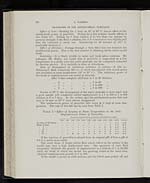Alexander Fleming (1881-1955)
On the antibacterial action of cultures of a penicillium with special reference to their use in the isolation of B. influenzae
228
A. FLEMING.
PROPERTIES OP THE ANTIBACTERIAL SUBSTANCE.
Effect of heat.—Heating for 1 hour at 56° or 80° C. has no effect on the
antibacterial power of penicillin. Boiling for a few minutes hardly affects it
(see Table II). Boiling for 1 hour reduces it to less than one quarter its
previous strength if the fluid is alkaline, but if it is neutral or very slightly acid
then the reduction is much less. Autoclaving for 20 minutes at 115° C.
practically destroys it.
Effect of filtration.—Passage through a Seitz filter does not diminish the
antibacterial power. This is the best method of obtaining sterile active mould
broth.
Solubility.—It is freely soluble in water and weak saline solutions. My
colleague, Mr. Ridley, has found that if penicillin is evaporated at a low
temperature to a sticky mass the active principle can be completely extracted
by absolute alcohol. It is insoluble in ether or chloroform.
Rate of development of inhibitory substance in culture.—A 500 c.c.
Erlenmeyer flask containing 200 c.c. of broth was planted with mould spores
and incubated at room temperature (10° to 20° C). The inhibitory power of
the broth to staphylococcus was tested at intervals.
| After 5 days complete inhibition in 1 in 20 dilution. | ||||||||
| ,, | 6 | ,, | ,, | ,, | ,, | 1 in 40 | ,, | |
| ,, | 7 | ,, | ,, | ,, | ,, | 1 in 200 | ,, | |
| ,, | 8 | ,, | ,, | ,, | ,, | 1 in 500 | ,, | |
Grown at 20° C. the development of the active principle is more rapid and
a good sample will completely inhibit staphylococci in a 1 in 500 or 1 in 800
dilution in 6 or 7 days. As the culture ages the antibacterial power falls and
may in 14 days at 20° C. have almost disappeared.
The antibacterial power of penicillin falls when it is kept at room tem-
perature. The rate of this fall can be seen from Table I.
| Table I.—Effect of Keeping at Room Temperature on the Anti- Staphylococcal Power of Penicillin. | ||||||||||||||
| Growth of staphylococcus in dilutious of penicillin as under. | ||||||||||||||
| 1/20. | 1/40. | 1/60. | 1/80. | 1/100. | 1/200. | 1/300. | 1/400. | 1/600. | 1/800. | 1/1000. | Control. | |||
| At time of filtration. | — | — | — | — | — | — | — | — | — | ± | ++ | ++ | ||
| After 4 days | — | — | — | — | — | — | — | — | — | ± | ++ | ++ | ||
| ,, | 7 | ,, | — | — | — | — | — | — | — | ± | + | + | ++ | ++ |
| ,, | 9 | ,, | — | — | — | — | — | — | — | ± | + | + | ++ | ++ |
| ,, | 13 | ,, | — | — | — | — | — | + | + | + | + | + | ++ | ++ |
| ,, | 15 | ,, | — | ± | + | + | + | + | + | + | + | + | ++ | ++ |
If the reaction of penicillin is altered from its original pH of 9 to a pH of
6·8 it is much more stable.
The small drops of bright yellow fluid which collect on the surface of the
mould may have a high antibacterial titre. One specimen of such fluid
completely inhibited the growth of staphylococci in a dilution of 1 in 20,000
while the broth in which the mould was growing, tested at the same time,
inhibited staphylococcal growth in 1 in 800.
If the mould is grown on solid medium and the felted mass picked off and


